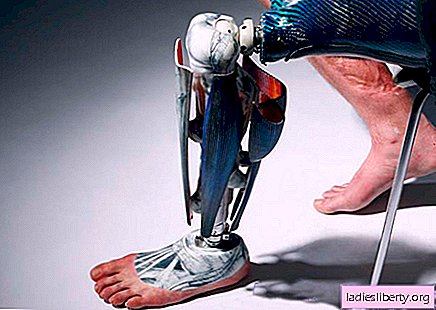
Lymphadenitis Behind such a pretentious and incomprehensible name lies a completely ordinary phenomenon - inflammation of the lymph nodes.
Almost everyone met with him, but not everyone suspects a pathology: mild pain is attributed to myositis and other diseases, united by the philistine term "pout."
Meanwhile, not everything is so simple. Lymphadenitis is threatening with its complications. Moreover, if the lymph node becomes inflamed, then, to paraphrase the famous French expression, "look for the source of inflammation."
The mechanism of development of lymphadenitis
The lymphatic system of the body is a complex and well-functioning mechanism. One of the main tasks of the lymph nodes is the transportation of lymphocytes and other immune cells. In this regard, the system can be compared with the subway. As soon as the penetration of foreign elements is observed in the body, the lymphatic system directs numerous immunity cells to the site of penetration. Lymphocytes attack a dangerous intruder, while they die themselves. Inflammation develops. The body localizes and isolates the war zone with a fibrous capsule. That is why with palpation of the inguinal region, neck, armpits, painless soft nodules can be found. In especially severe cases of cells, so many cells die that purulent exudate forms and a clinical picture of purulent inflammation of the lymph nodes develops. Perhaps the formation of sites of necrosis (which is even more dangerous).
At the first suspicion of the onset of lymphadenitis, it is recommended to immediately consult a doctor.
Causes of inguinal lymphadenitis
It is important to note that in extremely rare cases, lymphadenitis develops as a primary disease. Where more often we are talking about a secondary pathological process that occurs due to the course of inflammation in the body. Sources of inguinal lymphadenitis are numerous, as a rule, it is necessary to look for lesion factors in the vicinity of the affected node:
• Inflammatory diseases of the bladder and urogenital apparatus. "Record holder" among the causes of inguinal lymphadenitis. The essence of the disease is inflammation of the bladder. More rarely, the source of the disease becomes urethritis (inflammation of the urethra).
• Venereal diseases. Gonorrhea, syphilis, etc. They cause severe damage to the lymph nodes.
• Lesions of the external genitalia (inflammation of the glans penis, balanoposthitis, colpitis, etc.).
• Oncological diseases of nearby organs.
• Allergic reaction (extremely rare).
These are the immediate and most common causes of inguinal lymphadenitis. There are other, more rare:
• Infectious lesions of the oral cavity and upper respiratory tract (starting with caries and ending with tonsillitis, laryngitis, etc.).
• Inflammatory processes in the kidneys.
Lymph nodes in the groin collect lymph from the lower extremities and genitals, so the above causes of inguinal lymphadenitis are extremely rare. However, they cannot be excluded.
The first symptoms of inguinal lymphadenitis
Signs of inguinal lymphadenitis appear in patients in different ways. The specific manifestations depend on many factors: the initial state of health, the nature of the process, the causative agent of the disease, the degree of compression of nearby tissues. Acute lymphadenitis is most pronounced:
• Pain syndrome. The pain is localized in the area of the affected node, on the inner surface of the thigh. Discomfort gives to the legs, lower abdomen. The intensity of the pain is high. Among the first symptoms of inguinal lymphadenitis, this is the most common (even for a chronic process).
• Enlarged lymph node. In mild cases, an increase in the size of the node can be determined only by palpation. In heavy - everything is visible to the naked eye.
• Symptoms of general intoxication of the body. Observed only with a complicated process. This includes fever, chills, headache, weakness, etc.
• Changes in the skin. With a mild course of the disease, the skin above the lesion site retains its usual color. With suppuration, the skin is edematous, red, the inflamed node itself rises above it (appears as an abscess).
• Swelling of the lower extremities.
Signs of inguinal lymphadenitis vary. In a chronic course, a slight pain syndrome is observed. In most cases, the patient is unaware of health problems.
Diagnosis of inguinal lymphadenitis
Lymphadenitis itself will be detected without problems even by a novice specialist without much experience. But there is no point in treating this disease without eliminating the root cause. That is why the task of diagnosis is to identify the source of the lesion. Surgeons, therapists and urologists are involved in the treatment and diagnosis of such problems. It is with their consultation that the patient needs to start.
A huge role is given to laboratory diagnostic methods. Among them:
1) General blood test. Not sufficiently informative, however, it allows you to assess the condition of the body and identify inflammatory processes. The clinical picture is dominated by: leukocytosis, a high level of ESR. The rest of the analysis varies from patient to patient. A high level of neutrophils is characteristic of an infectious lesion, eosinophilia - for allergies, parasitic infestations, monocytosis accompanies venereal diseases.
2) General urine analysis. In the urine, a change in the indicators of protein and white blood cells is also possible.
To put an end to the diagnosis, instrumental studies are prescribed:
• Ultrasound examination of the lymph nodes. It makes it possible to assess the degree and nature of the lesion of the inguinal nodes. This study is especially important for choosing a treatment strategy.
• Radiography. It also allows you to assess the condition of lymph nodes and nearby structures.
• Biopsy. They rarely resort to it, mainly with suspicions of the oncological nature of the defeat of the lymph node.
Together, these methods are sufficient to make a diagnosis and identify the source of the problem.
Treatment of inguinal lymphadenitis
Treatment of inguinal lymphadenitis in most cases is conservative (medication). With the weakening of the pathological process and its transition to the subacute stage, physiotherapy is indicated. Medicines are selected by the attending specialist and only after a thorough diagnosis. The essence of therapy is to stop the signs of lymphadenitis and eliminate the source of damage. Among the medicines:
• Non-steroidal anti-inflammatory drugs (Ketorolac, Nise, Nimesil, etc.). Called to relieve inflammation. With their ineffectiveness, hormonal anti-inflammatory drugs are prescribed.
• Antihistamines. Called to suspend a violent immune response.
• Antibiotics.
• Antiviral drugs.
If the disease is caused by fungi or parasites, antifungal and anthelmintic drugs are prescribed, respectively.
In no case should you take the drugs yourself. This is fraught with a softening of the clinical picture. Thus, the patient complicates his life, and the doctor - the work.
Specific names of physiotherapy are prescribed by a physiotherapist.
As for surgery. They resort to it in extreme cases, if the process of the disease is complicated by a purulent lesion. Its essence is to remove dead tissue and pumping out pus.
What absolutely can not be done with inguinal lymphadenitis
"Recipes" of alternative treatment are widely spread on the Internet. Most of them are harmless, but there are hazardous to health. The most dangerous are two of them:
• Warming up the lymph nodes. It is strictly forbidden. Hot-water bottles, mustard plasters and other "methods" are quite capable of complicating the process of the disease, as the vessels expand sharply, an influx of new microorganisms and immune cells occurs. This is a direct path to purulent inflammation.
• Cooling lymph nodes with ice. It has the opposite effect: the vessels narrow, temporarily relieving the condition, then they expand sharply. The likely outcome is the same as in the case of heat.
Inguinal lymphadenitis prophylaxis
In order to avoid inflammation, it is enough to adhere to a number of recommendations:
• Do not overcool.
• Safe sex should be practiced.
• It is time to sanitize all possible sources of infection: carious teeth, sore throat, bladder, etc.
Lymphadenitis is by no means a harmless disease. He is quite capable of fatal. Therefore, it is so important to react in time and consult a treating specialist.











